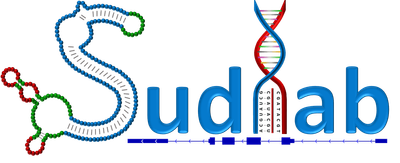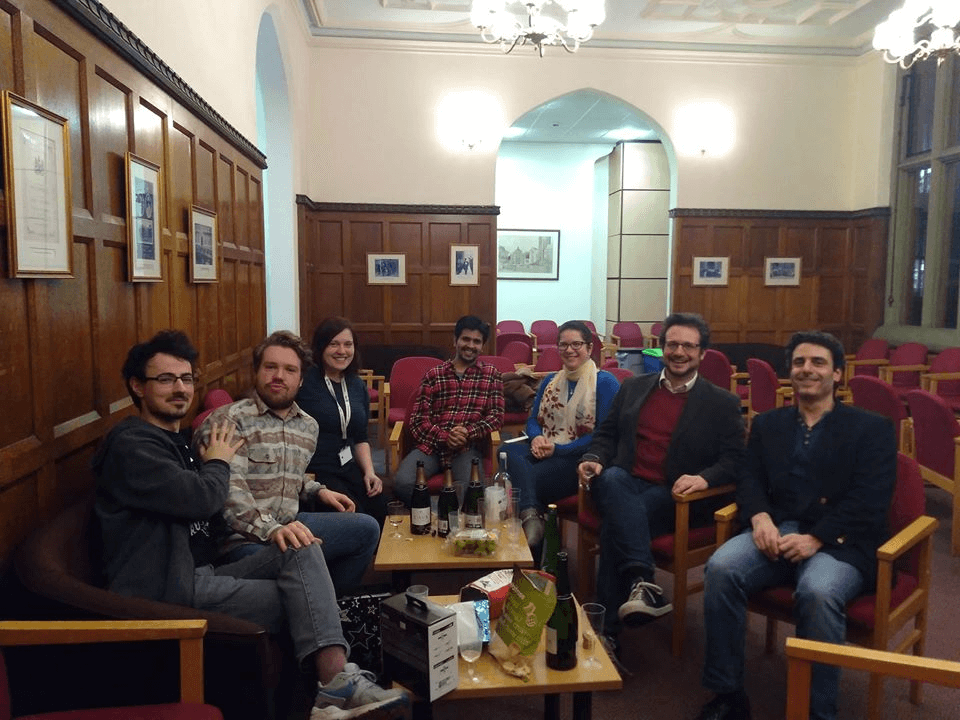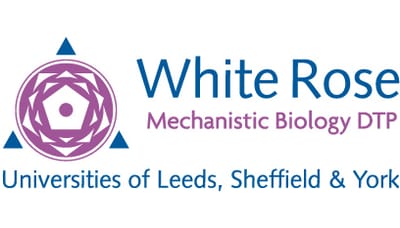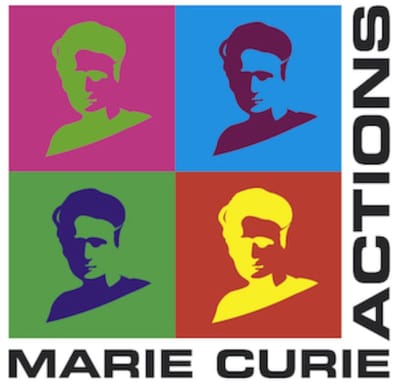
Analysis-first functional genomics, gene-expression and RNA biology
About

The research in Sudlab integrates the use computational genomics with molecular cell biology, to answer questions about gene expression. We are particularly interested in post-transcriptional gene-regulation and how it is encoded in the sequence. The continuous scientific advances over the years have seen an increase in profiling of large numbers of tissues and cell samples, emphasizing the need of developing high-throughput techniques for analysing such complex data.
Sudlab uses bioinformatic and functional genomics tools to answer questions on splice variants, the effects of non-coding variants, transcript and protein expression levels etc. We are generally focused on the biological question, but will develop new tools and approaches where it is necessary.
Sudlab was established by Dr Ian Sudbery at the University of Sheffield, in 2014. It is now a thriving community of research staff and postgraduate students (MBiolSci, MSc and PhD).
Sudlab uses bioinformatic and functional genomics tools to answer questions on splice variants, the effects of non-coding variants, transcript and protein expression levels etc. We are generally focused on the biological question, but will develop new tools and approaches where it is necessary.
Sudlab was established by Dr Ian Sudbery at the University of Sheffield, in 2014. It is now a thriving community of research staff and postgraduate students (MBiolSci, MSc and PhD).
Team
Now PostDoc with Prof. David James
Cristina Alexandru
Postdoctoral Research Associate (2018-2021)
Now Bioinformatics Developer at the University of Sheffield.
Magdalena Dabrowska
PhD Student (2016-2021)
Postdoctoral Fellow, Brigham and Women's Hospital, Boston, MA
Jacob Parker
PhD Student (2015-2019)
Research
Publications
Heterogeneous graph attention network improves cancer multiomics integration
Tabakhi S, Vandermeulen C, Sudbery I, Lu H
arXiv 05 Aug 2024 10.48550/arxiv.2408.02845
Read Here
Abstract
The increase in high-dimensional multiomics data demands advanced integration models to capture the complexity of human diseases. Graph-based deep learning integration models, despite their promise, struggle with small patient cohorts and high-dimensional features, often applying independent feature selection without modeling relationships among omics. Furthermore, conventional graph-based omics models focus on homogeneous graphs, lacking multiple types of nodes and edges to capture diverse structures. We introduce a Heterogeneous Graph ATtention network for omics integration (HeteroGATomics) to improve cancer diagnosis. HeteroGATomics performs joint feature selection through a multi-agent system, creating dedicated networks of feature and patient similarity for each omic modality. These networks are then combined into one heterogeneous graph for learning holistic omic-specific representations and integrating predictions across modalities. Experiments on three cancer multiomics datasets demonstrate HeteroGATomics' superior performance in cancer diagnosis. Moreover, HeteroGATomics enhances interpretability by identifying important biomarkers contributing to the diagnosis outcomes.
arXiv 05 Aug 2024 10.48550/arxiv.2408.02845
Read Here
Abstract
The increase in high-dimensional multiomics data demands advanced integration models to capture the complexity of human diseases. Graph-based deep learning integration models, despite their promise, struggle with small patient cohorts and high-dimensional features, often applying independent feature selection without modeling relationships among omics. Furthermore, conventional graph-based omics models focus on homogeneous graphs, lacking multiple types of nodes and edges to capture diverse structures. We introduce a Heterogeneous Graph ATtention network for omics integration (HeteroGATomics) to improve cancer diagnosis. HeteroGATomics performs joint feature selection through a multi-agent system, creating dedicated networks of feature and patient similarity for each omic modality. These networks are then combined into one heterogeneous graph for learning holistic omic-specific representations and integrating predictions across modalities. Experiments on three cancer multiomics datasets demonstrate HeteroGATomics' superior performance in cancer diagnosis. Moreover, HeteroGATomics enhances interpretability by identifying important biomarkers contributing to the diagnosis outcomes.
N6-methyladenosine modification is not a general trait of viral RNA genomes
Baquero-Pérez, B.; Yonchev, I. D.; Delgado-Tejedor, A.; Medina, R.; Puig-Torrents, M.; Sudbery, I.; Begik, O.; Wilson, S. A.; Novoa, E. M.; Díez, J.
Nature Communications 15(1) Article number 1964 11 Mar 2024;
10.1038/s41467-024-46278-9
Read Here
Abstract
Despite the nuclear localization of the m6A machinery, the genomes of multiple exclusively-cytoplasmic RNA viruses, such as chikungunya (CHIKV) and dengue (DENV), are reported to be extensively m6A-modified. However, these findings are mostly based on m6A-Seq, an antibody-dependent technique with a high rate of false positives. Here, we address the presence of m6A in CHIKV and DENV RNAs. For this, we combine m6A-Seq and the antibody-independent SELECT and nanopore direct RNA sequencing techniques with functional, molecular, and mutagenesis studies. Following this comprehensive analysis, we find no evidence of m6A modification in CHIKV or DENV transcripts. Furthermore, depletion of key components of the host m6A machinery does not affect CHIKV or DENV infection. Moreover, CHIKV or DENV infection has no effect on the m6A machinery’s localization. Our results challenge the prevailing notion that m6A modification is a general feature of cytoplasmic RNA viruses and underscore the importance of validating RNA modifications with orthogonal approaches.
Nature Communications 15(1) Article number 1964 11 Mar 2024;
10.1038/s41467-024-46278-9
Read Here
Abstract
Despite the nuclear localization of the m6A machinery, the genomes of multiple exclusively-cytoplasmic RNA viruses, such as chikungunya (CHIKV) and dengue (DENV), are reported to be extensively m6A-modified. However, these findings are mostly based on m6A-Seq, an antibody-dependent technique with a high rate of false positives. Here, we address the presence of m6A in CHIKV and DENV RNAs. For this, we combine m6A-Seq and the antibody-independent SELECT and nanopore direct RNA sequencing techniques with functional, molecular, and mutagenesis studies. Following this comprehensive analysis, we find no evidence of m6A modification in CHIKV or DENV transcripts. Furthermore, depletion of key components of the host m6A machinery does not affect CHIKV or DENV infection. Moreover, CHIKV or DENV infection has no effect on the m6A machinery’s localization. Our results challenge the prevailing notion that m6A modification is a general feature of cytoplasmic RNA viruses and underscore the importance of validating RNA modifications with orthogonal approaches.
Widespread 3’ UTR splicing regulates expression of oncogene transcripts in sequence-dependent and independent manners
Riley JJ, Alexandru-Crivac CN, Bryce-Smith S, Wilson SA, Sudbery IM
bioRxiv 12 Jan 2024; 10.1101/2024.01.10.575007
Abstract
Background Splicing in 3’ untranslated regions (3’ UTRs) is generally considered a signal to elicit transcript degradation via nonsense-mediated decay (NMD) due to the presence of an exon junction complex (EJC) downstream of the stop codon. However, 3’ UTR intron (3UI)-containing transcripts are widespread and highly expressed in both normal tissues and cancers.
Results Here we present and characterise a novel transcriptome assembly built from 7897 solid tumour and normal samples from The Cancer Genome Atlas. We identify thousands of 3UI-containing transcript isoforms, many of which are expressed across multiple cancer types. We find that the expression of core NMD component UPF1 negatively correlates with global 3UI splicing between normal samples, however this correlation is lost in colon cancer. We find that 3UIs found exclusively within 3’ UTRs (bona-fide 3UIs) are not predominantly NMD-sensitising, unlike introns present in 3’ UTRs due to premature termination. We identify HRAS as an example where 3UI splicing rescues the transcript from NMD. Bona-fide, but not premature termination codon (PTC) carrying 3UI-transcripts are spliced more in cancer samples compared to matched normals in the majority of cancer types analysed. In colon cancer, differentially spliced 3UI-containing transcripts are enriched in the canonical Wnt signalling pathway, with CTNNB1 being the most over-spliced in colon cancer compared to normal. We show that manipulating Wnt signalling can further regulate splicing of Wnt component transcript 3’ UTRs.
Conclusions Our results indicate that 3’ UTR splicing is not a rare occurrence, especially in colon cancer, where 3’ UTR splicing regulates transcript expression in EJC-dependent and independent manners.
bioRxiv 12 Jan 2024; 10.1101/2024.01.10.575007
Abstract
Background Splicing in 3’ untranslated regions (3’ UTRs) is generally considered a signal to elicit transcript degradation via nonsense-mediated decay (NMD) due to the presence of an exon junction complex (EJC) downstream of the stop codon. However, 3’ UTR intron (3UI)-containing transcripts are widespread and highly expressed in both normal tissues and cancers.
Results Here we present and characterise a novel transcriptome assembly built from 7897 solid tumour and normal samples from The Cancer Genome Atlas. We identify thousands of 3UI-containing transcript isoforms, many of which are expressed across multiple cancer types. We find that the expression of core NMD component UPF1 negatively correlates with global 3UI splicing between normal samples, however this correlation is lost in colon cancer. We find that 3UIs found exclusively within 3’ UTRs (bona-fide 3UIs) are not predominantly NMD-sensitising, unlike introns present in 3’ UTRs due to premature termination. We identify HRAS as an example where 3UI splicing rescues the transcript from NMD. Bona-fide, but not premature termination codon (PTC) carrying 3UI-transcripts are spliced more in cancer samples compared to matched normals in the majority of cancer types analysed. In colon cancer, differentially spliced 3UI-containing transcripts are enriched in the canonical Wnt signalling pathway, with CTNNB1 being the most over-spliced in colon cancer compared to normal. We show that manipulating Wnt signalling can further regulate splicing of Wnt component transcript 3’ UTRs.
Conclusions Our results indicate that 3’ UTR splicing is not a rare occurrence, especially in colon cancer, where 3’ UTR splicing regulates transcript expression in EJC-dependent and independent manners.
MAF functions as a pioneer transcription factor that initiates and sustains myelomagenesis
Katsarou, A.; Trasanidis, N.; Ponnusamy, K.; Kostopoulos, I. V.; Alvarez-Benayas, J.; Papaleonidopoulou, F.; Keren, K.; Sabbattini, P. M. R.; Feldhahn, N.; Papaioannou, M.; Hatjiharissi, E.; Sudbery, I. M.; Chaidos, A.; Caputo, V. S.; Karadimitris, A.
Blood Advances 2023: 7(21), 6395-6410; 10.1182/bloodadvances.2023009772
Read Here
Abstract
Deregulated expression of lineage-affiliated transcription factors (TFs) is a major mechanism of oncogenesis. However, how the deregulation of nonlineage affiliated TF affects chromatin to initiate oncogenic transcriptional programs is not well-known. To address this, we studied the chromatin effects imposed by oncogenic MAF as the cancer-initiating driver in the plasma cell cancer multiple myeloma. We found that the ectopically expressed MAF endows myeloma plasma cells with migratory and proliferative transcriptional potential. This potential is regulated by the activation of enhancers and superenhancers, previously inactive in healthy B cells and plasma cells, and the cooperation of MAF with the plasma cell-defining TF IRF4. Forced ectopic MAF expression confirms the de novo ability of oncogenic MAF to convert transcriptionally inert chromatin to active chromatin with the features of superenhancers, leading to the activation of the MAF-specific oncogenic transcriptome and the acquisition of cancer-related cellular phenotypes such as CCR1-dependent cell migration. These findings establish oncogenic MAF as a pioneer transcription factor that can initiate as well as sustain oncogenic transcriptomes and cancer phenotypes. However, despite its pioneer function, myeloma cells remain MAF-dependent, thus validating oncogenic MAF as a therapeutic target that would be able to circumvent the challenges of subsequent genetic diversification driving disease relapse and drug resistance.
Blood Advances 2023: 7(21), 6395-6410; 10.1182/bloodadvances.2023009772
Read Here
Abstract
Deregulated expression of lineage-affiliated transcription factors (TFs) is a major mechanism of oncogenesis. However, how the deregulation of nonlineage affiliated TF affects chromatin to initiate oncogenic transcriptional programs is not well-known. To address this, we studied the chromatin effects imposed by oncogenic MAF as the cancer-initiating driver in the plasma cell cancer multiple myeloma. We found that the ectopically expressed MAF endows myeloma plasma cells with migratory and proliferative transcriptional potential. This potential is regulated by the activation of enhancers and superenhancers, previously inactive in healthy B cells and plasma cells, and the cooperation of MAF with the plasma cell-defining TF IRF4. Forced ectopic MAF expression confirms the de novo ability of oncogenic MAF to convert transcriptionally inert chromatin to active chromatin with the features of superenhancers, leading to the activation of the MAF-specific oncogenic transcriptome and the acquisition of cancer-related cellular phenotypes such as CCR1-dependent cell migration. These findings establish oncogenic MAF as a pioneer transcription factor that can initiate as well as sustain oncogenic transcriptomes and cancer phenotypes. However, despite its pioneer function, myeloma cells remain MAF-dependent, thus validating oncogenic MAF as a therapeutic target that would be able to circumvent the challenges of subsequent genetic diversification driving disease relapse and drug resistance.
hnRNPUL1 ensures efficient Integrator-mediated cleavage of snRNAs and is mutated in amyotrophic lateral sclerosis
Yonchev, I. D.; Apostol, C. V.; Griffith, L.; Li, A.; Butler, L.; Patrick, H.; Aguilar-Martinez, E.; Whelan, A. G. R.; Evans, C.; Dickman, M. J.; Cooper-Knock, J.; Shaw, P. J.; West, S.; Barbaric, I.; Sudbery, I. M.; Wilson, S. A.
bioRxiv July 2023; 10.1101/2023.07.22.550030
Read Here
Abstract
Integrator cleaves nascent RNA, triggering RNA polymerase II transcription termination, but how cleavage is regulated is poorly understood. Here we show hnRNPUL1 ensures efficient Integrator-mediated cleavage of nascent RNA downstream of snRNA genes and, in the case of U2 snRNA, binds a terminal stem-loop involved in this process. In the nucleoplasm, hnRNPUL1 binds U4 snRNA and SART3 and enables efficient reformation of the U4:U6 di-snRNP for further rounds of pre-mRNA splicing. Sustained hnRNPUL1 loss leads to reduced levels of snRNAs, defects in histone mRNA 3′ end processing and loss of Cajal bodies. hnRNPUL1 binds RNA through multiple domains, including a globular central domain comprising tightly juxtaposed SPRY and dead polynucleotide kinase folds. This latter fold allows binding to 5′-monophosphorylated RNAs in a mutually exclusive manner with ATP binding and functions as an XRN2 antagonist when overexpressed. We identify a cohort of amyotrophic lateral sclerosis patients harbouring disruptive mutations in hnRNPUL1. SMN loss in spinal muscular atrophy and hnRNPUL1 loss both disrupt snRNP biogenesis, leading to motor neuron death, suggesting a common aetiology.
bioRxiv July 2023; 10.1101/2023.07.22.550030
Read Here
Abstract
Integrator cleaves nascent RNA, triggering RNA polymerase II transcription termination, but how cleavage is regulated is poorly understood. Here we show hnRNPUL1 ensures efficient Integrator-mediated cleavage of nascent RNA downstream of snRNA genes and, in the case of U2 snRNA, binds a terminal stem-loop involved in this process. In the nucleoplasm, hnRNPUL1 binds U4 snRNA and SART3 and enables efficient reformation of the U4:U6 di-snRNP for further rounds of pre-mRNA splicing. Sustained hnRNPUL1 loss leads to reduced levels of snRNAs, defects in histone mRNA 3′ end processing and loss of Cajal bodies. hnRNPUL1 binds RNA through multiple domains, including a globular central domain comprising tightly juxtaposed SPRY and dead polynucleotide kinase folds. This latter fold allows binding to 5′-monophosphorylated RNAs in a mutually exclusive manner with ATP binding and functions as an XRN2 antagonist when overexpressed. We identify a cohort of amyotrophic lateral sclerosis patients harbouring disruptive mutations in hnRNPUL1. SMN loss in spinal muscular atrophy and hnRNPUL1 loss both disrupt snRNP biogenesis, leading to motor neuron death, suggesting a common aetiology.
A mechanism for oxidative damage repair at gene regulatory elements
A mechanism for oxidative damage repair at gene regulatory elements
Ray S, Abugable AA, Parker J, Liversidge K, Palminha NM, Liao C, Acosta-Martin AE, Souza CDS, Jurga M, Sudbery I, El-Khamisy SF.
Nature. 2022
Sep;609(7929):1038-1047. doi: 10.1038/s41586-022-05217-8. Epub 2022 Sep 28. PMID: 36171374.
Read here
Oxidative genome damage is an unavoidable consequence of cellular metabolism. It arises at gene regulatory elements by epigenetic demethylation during transcriptional activation1,2. Here we show that promoters are protected from oxidative damage via a process mediated by the nuclear mitotic apparatus protein NuMA (also known as NUMA1). NuMA exhibits genomic occupancy approximately 100 bp around transcription start sites. It binds the initiating form of RNA polymerase II, pause-release factors and single-strand break repair (SSBR) components such as TDP1. The binding is increased on chromatin following oxidative damage, and TDP1 enrichment at damaged chromatin is facilitated by NuMA. Depletion of NuMA increases oxidative damage at promoters. NuMA promotes transcription by limiting the polyADP-ribosylation of RNA polymerase II, increasing its availability and release from pausing at promoters. Metabolic labelling of nascent RNA identifies genes that depend on NuMA for transcription including immediate-early response genes. Complementation of NuMA-deficient cells with a mutant that mediates binding to SSBR, or a mitotic separation-of-function mutant, restores SSBR defects. These findings underscore the importance of oxidative DNA damage repair at gene regulatory elements and describe a process that fulfils this function.
Ray S, Abugable AA, Parker J, Liversidge K, Palminha NM, Liao C, Acosta-Martin AE, Souza CDS, Jurga M, Sudbery I, El-Khamisy SF.
Nature. 2022
Sep;609(7929):1038-1047. doi: 10.1038/s41586-022-05217-8. Epub 2022 Sep 28. PMID: 36171374.
Read here
Oxidative genome damage is an unavoidable consequence of cellular metabolism. It arises at gene regulatory elements by epigenetic demethylation during transcriptional activation1,2. Here we show that promoters are protected from oxidative damage via a process mediated by the nuclear mitotic apparatus protein NuMA (also known as NUMA1). NuMA exhibits genomic occupancy approximately 100 bp around transcription start sites. It binds the initiating form of RNA polymerase II, pause-release factors and single-strand break repair (SSBR) components such as TDP1. The binding is increased on chromatin following oxidative damage, and TDP1 enrichment at damaged chromatin is facilitated by NuMA. Depletion of NuMA increases oxidative damage at promoters. NuMA promotes transcription by limiting the polyADP-ribosylation of RNA polymerase II, increasing its availability and release from pausing at promoters. Metabolic labelling of nascent RNA identifies genes that depend on NuMA for transcription including immediate-early response genes. Complementation of NuMA-deficient cells with a mutant that mediates binding to SSBR, or a mitotic separation-of-function mutant, restores SSBR defects. These findings underscore the importance of oxidative DNA damage repair at gene regulatory elements and describe a process that fulfils this function.
Chromatin-based, in cis and in trans regulatory rewiring underpins distinct oncogenic transcriptomes in multiple myeloma (Nat. Commun, 2021)
Alvarez-Benayas J*, Trasanidis N*, Katsarou A*, Ponnusamy K, Chaidos A, May PC, Xiao X, Bua M, Atta M, Roberts IAG, Auner HW, Hatjiharissi E, Papaioannou M, Caputo VS$, Sudbery IM$, Karadimitris A$. Nat Commun. 2021 Sep 14;12(1):5450
* Joint first
$ Joint Corresponding
Read here
Abstract
Multiple myeloma is a genetically heterogeneous cancer of the bone marrow plasma cells (PC). Distinct myeloma transcriptome profiles are primarily driven by myeloma initiating events (MIE) and converge into a mutually exclusive overexpression of the CCND1 and CCND2 oncogenes. Here, with reference to their normal counterparts, we find that myeloma PC enhanced chromatin accessibility combined with paired transcriptome profiling can classify MIE-defined genetic subgroups. Across and within different MM genetic subgroups, we ascribe regulation of genes and pathways critical for myeloma biology to unique or shared, developmentally activated or de novo formed candidate enhancers. Such enhancers co-opt recruitment of existing transcription factors, which although not transcriptionally deregulated per se, organise aberrant gene regulatory networks that help identify myeloma cell dependencies with prognostic impact. Finally, we identify and validate the critical super-enhancer that regulates ectopic expression of CCND2 in a subset of patients with MM and in chronic lymphocytic leukemia.
* Joint first
$ Joint Corresponding
Read here
Abstract
Multiple myeloma is a genetically heterogeneous cancer of the bone marrow plasma cells (PC). Distinct myeloma transcriptome profiles are primarily driven by myeloma initiating events (MIE) and converge into a mutually exclusive overexpression of the CCND1 and CCND2 oncogenes. Here, with reference to their normal counterparts, we find that myeloma PC enhanced chromatin accessibility combined with paired transcriptome profiling can classify MIE-defined genetic subgroups. Across and within different MM genetic subgroups, we ascribe regulation of genes and pathways critical for myeloma biology to unique or shared, developmentally activated or de novo formed candidate enhancers. Such enhancers co-opt recruitment of existing transcription factors, which although not transcriptionally deregulated per se, organise aberrant gene regulatory networks that help identify myeloma cell dependencies with prognostic impact. Finally, we identify and validate the critical super-enhancer that regulates ectopic expression of CCND2 in a subset of patients with MM and in chronic lymphocytic leukemia.
Tribbles-1 Expression and Its Function to Control Inflammatory Cytokines, Including Interleukin-8 Levels are Regulated by miRNAs in Macrophages and Prostate Cancer Cells (Front Immunol. 2020)
Niespolo C, Johnston JM, Deshmukh SR, Satam S, Shologu Z, Villacanas O, Sudbery IM, Wilson HL, Kiss-Toth E. Front Immunol. 2020 Nov 27;11:574046.
Read it here
Abstract
The pseudokinase TRIB1 controls cell function in a range of contexts, by regulating MAP kinase activation and mediating protein degradation via the COP1 ubiquitin ligase. TRIB1 regulates polarization of macrophages and dysregulated Trib1 expression in murine models has been shown to alter atherosclerosis burden and adipose homeostasis. Recently, TRIB1 has also been implicated in the pathogenesis of prostate cancer, where it is often overexpressed, even in the absence of genetic amplification. Well described TRIB1 effectors include MAP kinases and C/EBP transcription factors, both in immune cells and in carcinogenesis. However, the mechanisms that regulate TRIB1 itself remain elusive. Here, we show that the long and conserved 3'untranslated region (3'UTR) of TRIB1 is targeted by miRNAs in macrophage and prostate cancer models. By using a systematic in silico analysis, we identified multiple "high confidence" miRNAs potentially binding to the 3'UTR of TRIB1 and report that miR-101-3p and miR-132-3p are direct regulators of TRIB1 expression and function. Binding of miR-101-3p and miR-132-3p to the 3'UTR of TRIB1 mRNA leads to an increased transcription and secretion of interleukin-8. Our data demonstrate that modulation of TRIB1 by miRNAs alters the inflammatory profile of both human macrophages and prostate cancer cells.
Read it here
Abstract
The pseudokinase TRIB1 controls cell function in a range of contexts, by regulating MAP kinase activation and mediating protein degradation via the COP1 ubiquitin ligase. TRIB1 regulates polarization of macrophages and dysregulated Trib1 expression in murine models has been shown to alter atherosclerosis burden and adipose homeostasis. Recently, TRIB1 has also been implicated in the pathogenesis of prostate cancer, where it is often overexpressed, even in the absence of genetic amplification. Well described TRIB1 effectors include MAP kinases and C/EBP transcription factors, both in immune cells and in carcinogenesis. However, the mechanisms that regulate TRIB1 itself remain elusive. Here, we show that the long and conserved 3'untranslated region (3'UTR) of TRIB1 is targeted by miRNAs in macrophage and prostate cancer models. By using a systematic in silico analysis, we identified multiple "high confidence" miRNAs potentially binding to the 3'UTR of TRIB1 and report that miR-101-3p and miR-132-3p are direct regulators of TRIB1 expression and function. Binding of miR-101-3p and miR-132-3p to the 3'UTR of TRIB1 mRNA leads to an increased transcription and secretion of interleukin-8. Our data demonstrate that modulation of TRIB1 by miRNAs alters the inflammatory profile of both human macrophages and prostate cancer cells.
Macrophage polarisation associated with atherosclerosis differentially affects their capacity to handle lipids (Atherosclerosis. 2020)
Baidžajevas K, Hadadi É, Lee B, Lum J, Shihui F, Sudbery I, Kiss-Tóth E, Wong SC, Wilson HL. Atherosclerosis. 2020 Jul;305:10-18.
Abstract
Background and aims: Lipid-rich foam cell macrophages drive atherosclerosis via several mechanisms, including inflammation, lipid uptake, lipid deposition and plaque vulnerability. The atheroma environment shapes macrophage function and phenotype; anti-inflammatory macrophages improve plaque stability while pro-inflammatory macrophages promote rupture. Current evidence suggests a variety of macrophage phenotypes occur in atherosclerotic plaques with local lipids, cytokines, oxidised phospholipids and pathogenic stimuli altering their phenotype. In this study, we addressed differential functioning of macrophage phenotypes via a systematic analysis of in vitro polarised, human monocyte-derived macrophage phenotypes, focussing on molecular events that regulate foam-cell formation.
Methods: We examined transcriptomes, protein levels and functionally determined lipid handling and foam cell formation capacity in macrophages polarised with IFNγ+LPS, IL-4, IL-10, oxPAPC and CXCL4.
Results: RNA sequencing of differentially polarised macrophages revealed distinct gene expression changes, with enrichment in atherosclerosis and lipid-associated pathways. Analysis of lipid processing activity showed IL-4 and IL-10 macrophages have higher lipid uptake and foam cell formation activities, while inflammatory and oxPAPC macrophages displayed lower foam cell formation. Inflammatory macrophages showed low lipid uptake, while higher lipid uptake in oxPAPC macrophages was matched by increased lipid efflux capacity.
Conclusions: Atherosclerosis-associated macrophage polarisation dramatically affects lipid handling capacity underpinned by major transcriptomic changes and altered protein levels in lipid-handling gene expression. This leads to phenotype-specific differences in LDL uptake, cellular cholesterol levels and cholesterol efflux, informing how the plaque environment influences atherosclerosis progression by influencing macrophage phenotypes.
Abstract
Background and aims: Lipid-rich foam cell macrophages drive atherosclerosis via several mechanisms, including inflammation, lipid uptake, lipid deposition and plaque vulnerability. The atheroma environment shapes macrophage function and phenotype; anti-inflammatory macrophages improve plaque stability while pro-inflammatory macrophages promote rupture. Current evidence suggests a variety of macrophage phenotypes occur in atherosclerotic plaques with local lipids, cytokines, oxidised phospholipids and pathogenic stimuli altering their phenotype. In this study, we addressed differential functioning of macrophage phenotypes via a systematic analysis of in vitro polarised, human monocyte-derived macrophage phenotypes, focussing on molecular events that regulate foam-cell formation.
Methods: We examined transcriptomes, protein levels and functionally determined lipid handling and foam cell formation capacity in macrophages polarised with IFNγ+LPS, IL-4, IL-10, oxPAPC and CXCL4.
Results: RNA sequencing of differentially polarised macrophages revealed distinct gene expression changes, with enrichment in atherosclerosis and lipid-associated pathways. Analysis of lipid processing activity showed IL-4 and IL-10 macrophages have higher lipid uptake and foam cell formation activities, while inflammatory and oxPAPC macrophages displayed lower foam cell formation. Inflammatory macrophages showed low lipid uptake, while higher lipid uptake in oxPAPC macrophages was matched by increased lipid efflux capacity.
Conclusions: Atherosclerosis-associated macrophage polarisation dramatically affects lipid handling capacity underpinned by major transcriptomic changes and altered protein levels in lipid-handling gene expression. This leads to phenotype-specific differences in LDL uptake, cellular cholesterol levels and cholesterol efflux, informing how the plaque environment influences atherosclerosis progression by influencing macrophage phenotypes.
Co-transcriptional Loading of RNA Export Factors Shapes the Human Transcriptome (Molecular Cell, 2019)
Viphakone N, Sudbery I, Griffith L, Heath CG, Sims D & Wilson SA (2019). Moelcular Cell, VOLUME 75, ISSUE 2, P310-323.E8
Read article here
Abstract
During gene expression, RNA export factors are mainly known for driving nucleo-cytoplasmic transport. While early studies suggested that the exon junction complex (EJC) provides a binding platform for them, subsequent work proposed that they are only recruited by the cap binding complex to the 5′ end of RNAs, as part of TREX. Using iCLIP, we show that the export receptor Nxf1 and two TREX subunits, Alyref and Chtop, are recruited to the whole mRNA co-transcriptionally via splicing but before 3′ end processing. Consequently, Alyref alters splicing decisions and Chtop regulates alternative polyadenylation. Alyref is recruited to the 5′ end of RNAs by CBC, and our data reveal subsequent binding to RNAs near EJCs. We demonstrate that eIF4A3 stimulates Alyref deposition not only on spliced RNAs close to EJC sites but also on single-exon transcripts. Our study reveals mechanistic insights into the co-transcriptional recruitment of mRNA export factors and how this shapes the human transcriptome.
Read article here
Abstract
During gene expression, RNA export factors are mainly known for driving nucleo-cytoplasmic transport. While early studies suggested that the exon junction complex (EJC) provides a binding platform for them, subsequent work proposed that they are only recruited by the cap binding complex to the 5′ end of RNAs, as part of TREX. Using iCLIP, we show that the export receptor Nxf1 and two TREX subunits, Alyref and Chtop, are recruited to the whole mRNA co-transcriptionally via splicing but before 3′ end processing. Consequently, Alyref alters splicing decisions and Chtop regulates alternative polyadenylation. Alyref is recruited to the 5′ end of RNAs by CBC, and our data reveal subsequent binding to RNAs near EJCs. We demonstrate that eIF4A3 stimulates Alyref deposition not only on spliced RNAs close to EJC sites but also on single-exon transcripts. Our study reveals mechanistic insights into the co-transcriptional recruitment of mRNA export factors and how this shapes the human transcriptome.
Alevin efficiently estimates accurate gene abundances from dscRNA-seq data (Genome Biology, 2019)
Srivastava A, Malik L, Smith T, Sudbery I & Patro R (2019). Genome Biology, 20.
Read article here
Abstract
We introduce alevin, a fast end-to-end pipeline to process droplet-based single-cell RNA sequencing data, performing cell barcode detection, read mapping, unique molecular identifier (UMI) deduplication, gene count estimation, and cell barcode whitelisting. Alevin’s approach to UMI deduplication considers transcript-level constraints on the molecules from which UMIs may have arisen and accounts for both gene-unique reads and reads that multimap between genes. This addresses the inherent bias in existing tools which discard gene-ambiguous reads and improves the accuracy of gene abundance estimates. Alevin is considerably faster, typically eight times, than existing gene quantification approaches, while also using less memory.
Read article here
Abstract
We introduce alevin, a fast end-to-end pipeline to process droplet-based single-cell RNA sequencing data, performing cell barcode detection, read mapping, unique molecular identifier (UMI) deduplication, gene count estimation, and cell barcode whitelisting. Alevin’s approach to UMI deduplication considers transcript-level constraints on the molecules from which UMIs may have arisen and accounts for both gene-unique reads and reads that multimap between genes. This addresses the inherent bias in existing tools which discard gene-ambiguous reads and improves the accuracy of gene abundance estimates. Alevin is considerably faster, typically eight times, than existing gene quantification approaches, while also using less memory.
Proteins that physically interact with the phosphatase Cdc14 in Candida albicans have diverse roles in the cell cycle (Scientific Reports, 2019)
Kaneva IN, Sudbery IM, Dickman MJ & Sudbery PE (2019). Scientific Reports, 9.
Read article here
Abstract
The chromosome complement of the human fungal pathogen Candida albicans is unusually unstable, suggesting that the process of nuclear division is error prone. The Cdc14 phosphatase plays a key role in organising the intricate choreography of mitosis and cell division. In order to understand the role of Cdc14 in C. albicans we used quantitative proteomics to identify proteins that physically interact with Cdc14. To distinguish genuine Cdc14-interactors from proteins that bound non-specifically to the affinity matrix, we used a substrate trapping mutant combined with mass spectrometry analysis using Stable Isotope Labelling with Amino Acids in Cell Culture (SILAC). The results identified 126 proteins that interact with Cdc14 of which 80% have not previously been identified as Cdc14 interactors in C. albicans or S. cerevisiae. In this set, 55 proteins are known from previous research in S. cerevisiae and S. pombe to play roles in the cell cycle, regulating the attachment of the mitotic spindle to kinetochores, mitotic exit, cytokinesis, licensing of DNA replication by re-activating pre-replication complexes, and DNA repair. Five Cdc14-interacting proteins with previously unknown functions localised to the Spindle Pole Bodies (SPBs). Thus, we have greatly increased the number of proteins that physically interact with Cdc14 in C. albicans.
Read article here
Abstract
The chromosome complement of the human fungal pathogen Candida albicans is unusually unstable, suggesting that the process of nuclear division is error prone. The Cdc14 phosphatase plays a key role in organising the intricate choreography of mitosis and cell division. In order to understand the role of Cdc14 in C. albicans we used quantitative proteomics to identify proteins that physically interact with Cdc14. To distinguish genuine Cdc14-interactors from proteins that bound non-specifically to the affinity matrix, we used a substrate trapping mutant combined with mass spectrometry analysis using Stable Isotope Labelling with Amino Acids in Cell Culture (SILAC). The results identified 126 proteins that interact with Cdc14 of which 80% have not previously been identified as Cdc14 interactors in C. albicans or S. cerevisiae. In this set, 55 proteins are known from previous research in S. cerevisiae and S. pombe to play roles in the cell cycle, regulating the attachment of the mitotic spindle to kinetochores, mitotic exit, cytokinesis, licensing of DNA replication by re-activating pre-replication complexes, and DNA repair. Five Cdc14-interacting proteins with previously unknown functions localised to the Spindle Pole Bodies (SPBs). Thus, we have greatly increased the number of proteins that physically interact with Cdc14 in C. albicans.
CGAT-core: a python framework for building scalable, reproducible computational biology workflows (F100Research, 2019)
Cribbs AP, Luna-Valero S, George C, Sudbery IM, Berlanga-Taylor AJ, Sansom SN, Smith T, Ilott NE, Johnson J, Scaber J , Brown K et al (2019). F1000Research, 8, 377-377.
Read article here: version 1 and version 2
Abstract
In the genomics era computational biologists regularly need to process, analyse and integrate large and complex biomedical datasets. Analysis inevitably involves multiple dependent steps, resulting in complex pipelines or workflows, often with several branches. Large data volumes mean that processing needs to be quick and efficient and scientific rigour requires that analysis be consistent and fully reproducible. We have developed CGAT-core, a python package for the rapid construction of complex computational workflows. CGAT-core seamlessly handles parallelisation across high performance computing clusters, integration of Conda environments, full parameterisation, database integration and logging. To illustrate our workflow framework, we present a pipeline for the analysis of RNAseq data using pseudo-alignment.
Read article here: version 1 and version 2
Abstract
In the genomics era computational biologists regularly need to process, analyse and integrate large and complex biomedical datasets. Analysis inevitably involves multiple dependent steps, resulting in complex pipelines or workflows, often with several branches. Large data volumes mean that processing needs to be quick and efficient and scientific rigour requires that analysis be consistent and fully reproducible. We have developed CGAT-core, a python package for the rapid construction of complex computational workflows. CGAT-core seamlessly handles parallelisation across high performance computing clusters, integration of Conda environments, full parameterisation, database integration and logging. To illustrate our workflow framework, we present a pipeline for the analysis of RNAseq data using pseudo-alignment.
The m6A-methylase complex recruits TREX and regulates mRNA export (Scientifc Reports, 2018)
Lesbirel S, Viphakone N, Parker M, Parker J, Heath C, Sudbery I & Wilson SA (2018). Scientific Reports, 8(1).
Read article here
Abstract
N6-methyladenosine (m6A) is the most abundant internal modification of eukaryotic mRNA. This modification has previously been shown to alter the export kinetics for mRNAs though the molecular details surrounding this phenomenon remain poorly understood. Recruitment of the TREX mRNA export complex to mRNA is driven by transcription, 5′ capping and pre-mRNA splicing. Here we identify a fourth mechanism in human cells driving the association of TREX with mRNA involving the m6A methylase complex. We show that the m6A complex recruits TREX to m6A modified mRNAs and this process is essential for their efficient export. TREX also stimulates recruitment of the m6A reader protein YTHDC1 to the mRNA and the m6A complex influences the interaction of TREX with YTHDC1. Together our studies reveal a key role for TREX in the export of m6A modified mRNAs.
Read article here
Abstract
N6-methyladenosine (m6A) is the most abundant internal modification of eukaryotic mRNA. This modification has previously been shown to alter the export kinetics for mRNAs though the molecular details surrounding this phenomenon remain poorly understood. Recruitment of the TREX mRNA export complex to mRNA is driven by transcription, 5′ capping and pre-mRNA splicing. Here we identify a fourth mechanism in human cells driving the association of TREX with mRNA involving the m6A methylase complex. We show that the m6A complex recruits TREX to m6A modified mRNAs and this process is essential for their efficient export. TREX also stimulates recruitment of the m6A reader protein YTHDC1 to the mRNA and the m6A complex influences the interaction of TREX with YTHDC1. Together our studies reveal a key role for TREX in the export of m6A modified mRNAs.
UCHL3 Regulates Topoisomerase-Induced Chromosomal Break Repair by Controlling TDP1 Proteostasis (Cell Reports, 2018)
Liao C, Beveridge R, Hudson JJR, Parker JD, Chiang S-C, Ray S, Ashour ME, Sudbery I, Dickman MJ & El-Khamisy SF (2018). Cell Reports, 23(11), 3352-3365.
Read article here
Abstract
Genomic damage can feature DNA-protein crosslinks whereby their acute accumulation is utilized to treat cancer and progressive accumulation causes neurodegeneration. This is typified by tyrosyl DNA phosphodiesterase 1 (TDP1), which repairs topoisomerase-mediated chromosomal breaks. Although TDP1 levels vary in multiple clinical settings, the mechanism underpinning this variation is unknown. We reveal that TDP1 is controlled by ubiquitylation and identify UCHL3 as the deubiquitylase that controls TDP1 proteostasis. Depletion of UCHL3 increases TDP1 ubiquitylation and turnover rate and sensitizes cells to TOP1 poisons. Overexpression of UCHL3, but not a catalytically inactive mutant, suppresses TDP1 ubiquitylation and turnover rate. TDP1 overexpression in the topoisomerase therapy-resistant rhabdomyosarcoma is driven by UCHL3 overexpression. In contrast, UCHL3 is downregulated in spinocerebellar ataxia with axonal neuropathy (SCAN1), causing elevated levels of TDP1 ubiquitylation and faster turnover rate. These data establish UCHL3 as a regulator of TDP1 proteostasis and, consequently, a fine-tuner of protein-linked DNA break repair.
Read article here
Abstract
Genomic damage can feature DNA-protein crosslinks whereby their acute accumulation is utilized to treat cancer and progressive accumulation causes neurodegeneration. This is typified by tyrosyl DNA phosphodiesterase 1 (TDP1), which repairs topoisomerase-mediated chromosomal breaks. Although TDP1 levels vary in multiple clinical settings, the mechanism underpinning this variation is unknown. We reveal that TDP1 is controlled by ubiquitylation and identify UCHL3 as the deubiquitylase that controls TDP1 proteostasis. Depletion of UCHL3 increases TDP1 ubiquitylation and turnover rate and sensitizes cells to TOP1 poisons. Overexpression of UCHL3, but not a catalytically inactive mutant, suppresses TDP1 ubiquitylation and turnover rate. TDP1 overexpression in the topoisomerase therapy-resistant rhabdomyosarcoma is driven by UCHL3 overexpression. In contrast, UCHL3 is downregulated in spinocerebellar ataxia with axonal neuropathy (SCAN1), causing elevated levels of TDP1 ubiquitylation and faster turnover rate. These data establish UCHL3 as a regulator of TDP1 proteostasis and, consequently, a fine-tuner of protein-linked DNA break repair.
UMI-tools: modeling sequencing errors in Unique Molecular Identifiers to improve quantification accuracy (Genome Research, 2017)
Smith TS, Heger A & Sudbery I (2017). Genome Research, 27, 491-499.
Read article here
Abstract
Unique Molecular Identifiers (UMIs) are random oligonucleotide barcodes that are increasingly used in high-throughput sequencing experiments. Through a UMI, identical copies arising from distinct molecules can be distinguished from those arising through PCR amplification of the same molecule. However, bioinformatic methods to leverage the information from UMIs have yet to be formalized. In particular, sequencing errors in the UMI sequence are often ignored or else resolved in an ad hoc manner. We show that errors in the UMI sequence are common and introduce network-based methods to account for these errors when identifying PCR duplicates. Using these methods, we demonstrate improved quantification accuracy both under simulated conditions and real iCLIP and single-cell RNA-seq data sets. Reproducibility between iCLIP replicates and single-cell RNA-seq clustering are both improved using our proposed network-based method, demonstrating the value of properly accounting for errors in UMIs. These methods are implemented in the open source UMI-tools software package.
Read article here
Abstract
Unique Molecular Identifiers (UMIs) are random oligonucleotide barcodes that are increasingly used in high-throughput sequencing experiments. Through a UMI, identical copies arising from distinct molecules can be distinguished from those arising through PCR amplification of the same molecule. However, bioinformatic methods to leverage the information from UMIs have yet to be formalized. In particular, sequencing errors in the UMI sequence are often ignored or else resolved in an ad hoc manner. We show that errors in the UMI sequence are common and introduce network-based methods to account for these errors when identifying PCR duplicates. Using these methods, we demonstrate improved quantification accuracy both under simulated conditions and real iCLIP and single-cell RNA-seq data sets. Reproducibility between iCLIP replicates and single-cell RNA-seq clustering are both improved using our proposed network-based method, demonstrating the value of properly accounting for errors in UMIs. These methods are implemented in the open source UMI-tools software package.
Cell Cycle-Independent Phospho-Regulation of Fkh2 during Hyphal Growth Regulates Candida albicans Pathogenesis (PLOS Pathogens, 2015)
Greig JA, Sudbery IM, Richardson JP, Naglik JR, Wang Y & Sudbery PE (2015). PLOS Pathogens, 11(1), e1004630-e1004630.
Read article here
Abstract
The opportunistic human fungal pathogen, Candida albicans, undergoes morphological and transcriptional adaptation in the switch from commensalism to pathogenicity. Although previous gene-knockout studies have identified many factors involved in this transformation, it remains unclear how these factors are regulated to coordinate the switch. Investigating morphogenetic control by post-translational phosphorylation has generated important regulatory insights into this process, especially focusing on coordinated control by the cyclin-dependent kinase Cdc28. Here we have identified the Fkh2 transcription factor as a regulatory target of both Cdc28 and the cell wall biosynthesis kinase Cbk1, in a role distinct from its conserved function in cell cycle progression. In stationary phase yeast cells 2D gel electrophoresis shows that there is a diverse pool of Fkh2 phospho-isoforms. For a short window on hyphal induction, far before START in the cell cycle, the phosphorylation profile is transformed before reverting to the yeast profile. This transformation does not occur when stationary phase cells are reinoculated into fresh medium supporting yeast growth. Mass spectrometry and mutational analyses identified residues phosphorylated by Cdc28 and Cbk1. Substitution of these residues with non-phosphorylatable alanine altered the yeast phosphorylation profile and abrogated the characteristic transformation to the hyphal profile. Transcript profiling of the phosphorylation site mutant revealed that the hyphal phosphorylation profile is required for the expression of genes involved in pathogenesis, host interaction and biofilm formation. We confirmed that these changes in gene expression resulted in corresponding defects in pathogenic processes. Furthermore, we identified that Fkh2 interacts with the chromatin modifier Pob3 in a phosphorylation-dependent manner, thereby providing a possible mechanism by which the phosphorylation of Fkh2 regulates its specificity. Thus, we have discovered a novel cell cycle-independent phospho-regulatory event that subverts a key component of the cell cycle machinery to a role in the switch from commensalism to pathogenicity.
Read article here
Abstract
The opportunistic human fungal pathogen, Candida albicans, undergoes morphological and transcriptional adaptation in the switch from commensalism to pathogenicity. Although previous gene-knockout studies have identified many factors involved in this transformation, it remains unclear how these factors are regulated to coordinate the switch. Investigating morphogenetic control by post-translational phosphorylation has generated important regulatory insights into this process, especially focusing on coordinated control by the cyclin-dependent kinase Cdc28. Here we have identified the Fkh2 transcription factor as a regulatory target of both Cdc28 and the cell wall biosynthesis kinase Cbk1, in a role distinct from its conserved function in cell cycle progression. In stationary phase yeast cells 2D gel electrophoresis shows that there is a diverse pool of Fkh2 phospho-isoforms. For a short window on hyphal induction, far before START in the cell cycle, the phosphorylation profile is transformed before reverting to the yeast profile. This transformation does not occur when stationary phase cells are reinoculated into fresh medium supporting yeast growth. Mass spectrometry and mutational analyses identified residues phosphorylated by Cdc28 and Cbk1. Substitution of these residues with non-phosphorylatable alanine altered the yeast phosphorylation profile and abrogated the characteristic transformation to the hyphal profile. Transcript profiling of the phosphorylation site mutant revealed that the hyphal phosphorylation profile is required for the expression of genes involved in pathogenesis, host interaction and biofilm formation. We confirmed that these changes in gene expression resulted in corresponding defects in pathogenic processes. Furthermore, we identified that Fkh2 interacts with the chromatin modifier Pob3 in a phosphorylation-dependent manner, thereby providing a possible mechanism by which the phosphorylation of Fkh2 regulates its specificity. Thus, we have discovered a novel cell cycle-independent phospho-regulatory event that subverts a key component of the cell cycle machinery to a role in the switch from commensalism to pathogenicity.
CGAT: computational genomics analysis toolkit (Bioinformatics, 2014)
Sims D, Ilott NE, Sansom SN, Sudbery IM, Johnson JS, Fawcett KA, Berlanga-Taylor AJ, Luna-Valero S, Ponting CP & Heger A (2014). Bioinformatics, 30(9), 1290-1291.
Read article here
Abstract
Summary: Computational genomics seeks to draw biological inferences from genomic datasets, often by integrating and contextualizing next-generation sequencing data. CGAT provides an extensive suite of tools designed to assist in the analysis of genome scale data from a range of standard file formats. The toolkit enables filtering, comparison, conversion, summarization and annotation of genomic intervals, gene sets and sequences. The tools can both be run from the Unix command line and installed into visual workflow builders, such as Galaxy.
Availability: The toolkit is freely available from http://github.com/CGATOxford/cgat
Read article here
Abstract
Summary: Computational genomics seeks to draw biological inferences from genomic datasets, often by integrating and contextualizing next-generation sequencing data. CGAT provides an extensive suite of tools designed to assist in the analysis of genome scale data from a range of standard file formats. The toolkit enables filtering, comparison, conversion, summarization and annotation of genomic intervals, gene sets and sequences. The tools can both be run from the Unix command line and installed into visual workflow builders, such as Galaxy.
Availability: The toolkit is freely available from http://github.com/CGATOxford/cgat
Sequencing depth and coverage: key considerations in genomic analyses (Nature Reviews, 2014)
Sims D, Sudbery I, Ilott NE, Heger A & Ponting CP (2014). Nature Reviews Genetics, 15(2), 121-132.
Read article here
Abstract
Sequencing technologies have placed a wide range of genomic analyses within the capabilities of many laboratories. However, sequencing costs often set limits to the amount of sequences that can be generated and, consequently, the biological outcomes that can be achieved from an experimental design. In this Review, we discuss the issue of sequencing depth in the design of next-generation sequencing experiments. We review current guidelines and precedents on the issue of coverage, as well as their underlying considerations, for four major study designs, which include de novo genome sequencing, genome resequencing, transcriptome sequencing and genomic location analyses (for example, chromatin immunoprecipitation followed by sequencing (ChIP–seq) and chromosome conformation capture (3C)).
Read article here
Abstract
Sequencing technologies have placed a wide range of genomic analyses within the capabilities of many laboratories. However, sequencing costs often set limits to the amount of sequences that can be generated and, consequently, the biological outcomes that can be achieved from an experimental design. In this Review, we discuss the issue of sequencing depth in the design of next-generation sequencing experiments. We review current guidelines and precedents on the issue of coverage, as well as their underlying considerations, for four major study designs, which include de novo genome sequencing, genome resequencing, transcriptome sequencing and genomic location analyses (for example, chromatin immunoprecipitation followed by sequencing (ChIP–seq) and chromosome conformation capture (3C)).
Phosphoregulation of Nap1 Plays a Role in Septin Ring Dynamics and Morphogenesis in Candida albicans (mBio, 2014)
Huang Z-X, Zhao P, Zeng G-S, Wang Y-M, Sudbery I & Wang Y (2014). mBio, 5(1).
Read article here
Abstract
Nap1 has long been identified as a potential septin regulator in yeasts. However, its function and regulation remain poorly defined. Here, we report functional characterization of Nap1 in the human-pathogenic fungus Candida albicans. We find that deletion of NAP1 causes constitutive filamentous growth and changes of septin dynamics. We present evidence that Nap1’s cellular localization and function are regulated by phosphorylation. Phos-tag gel electrophoresis revealed that Nap1 phosphorylation is cell cycle dependent, exhibiting the lowest level around the time of bud emergence. Mass spectrometry identified 10 phosphoserine and phosphothreonine residues in a cluster near the N terminus, and mutation of these residues affected Nap1’s localization to the septin ring and cellular function. Nap1 phosphorylation involves two septin ring-associated kinases, Cla4 and Gin4, and its dephosphorylation occurs at the septin ring in a manner dependent on the phosphatases PP2A and Cdc14. Furthermore, the nap1Δ/Δ mutant and alleles carrying mutations of the phosphorylation sites exhibited greatly reduced virulence in a mouse model of systemic candidiasis. Together, our findings not only provide new mechanistic insights into Nap1’s function and regulation but also suggest the potential to target Nap1 in future therapeutic design.
IMPORTANCE
Septins are conserved filament-forming GTPases involved in a wide range of cellular events, such as cytokinesis, exocytosis, and morphogenesis. In Candida albicans, the most prevalent human fungal pathogen, septin functions are indispensable for its virulence. However, the molecular mechanisms by which septin structures are regulated are poorly understood. In this study, we deleted NAP1, a gene encoding a putative septin regulator, in C. albicans and found that cells lacking NAP1 showed abnormalities in morphology, invasive growth, and septin ring dynamics. We identified a conserved N-terminal phosphorylation cluster on Nap1 and demonstrated that phosphorylation at these sites regulates Nap1 localization and function. Importantly, deletion of NAP1 or mutation in the N-terminal phosphorylation cluster strongly reduced the virulence of C. albicans in a mouse model of systemic infection. Thus, this study not only provides mechanistic insights into septin regulation but also suggests Nap1 as a potential antifungal target.
Read article here
Abstract
Nap1 has long been identified as a potential septin regulator in yeasts. However, its function and regulation remain poorly defined. Here, we report functional characterization of Nap1 in the human-pathogenic fungus Candida albicans. We find that deletion of NAP1 causes constitutive filamentous growth and changes of septin dynamics. We present evidence that Nap1’s cellular localization and function are regulated by phosphorylation. Phos-tag gel electrophoresis revealed that Nap1 phosphorylation is cell cycle dependent, exhibiting the lowest level around the time of bud emergence. Mass spectrometry identified 10 phosphoserine and phosphothreonine residues in a cluster near the N terminus, and mutation of these residues affected Nap1’s localization to the septin ring and cellular function. Nap1 phosphorylation involves two septin ring-associated kinases, Cla4 and Gin4, and its dephosphorylation occurs at the septin ring in a manner dependent on the phosphatases PP2A and Cdc14. Furthermore, the nap1Δ/Δ mutant and alleles carrying mutations of the phosphorylation sites exhibited greatly reduced virulence in a mouse model of systemic candidiasis. Together, our findings not only provide new mechanistic insights into Nap1’s function and regulation but also suggest the potential to target Nap1 in future therapeutic design.
IMPORTANCE
Septins are conserved filament-forming GTPases involved in a wide range of cellular events, such as cytokinesis, exocytosis, and morphogenesis. In Candida albicans, the most prevalent human fungal pathogen, septin functions are indispensable for its virulence. However, the molecular mechanisms by which septin structures are regulated are poorly understood. In this study, we deleted NAP1, a gene encoding a putative septin regulator, in C. albicans and found that cells lacking NAP1 showed abnormalities in morphology, invasive growth, and septin ring dynamics. We identified a conserved N-terminal phosphorylation cluster on Nap1 and demonstrated that phosphorylation at these sites regulates Nap1 localization and function. Importantly, deletion of NAP1 or mutation in the N-terminal phosphorylation cluster strongly reduced the virulence of C. albicans in a mouse model of systemic infection. Thus, this study not only provides mechanistic insights into septin regulation but also suggests Nap1 as a potential antifungal target.
Next-generation Sequencing of Advanced Prostate Cancer Treated with Androgen-deprivation Therapy (European Urology, 2014)
Rajan P, Sudbery IM, Villasevil MEM, Mui E, Fleming J, Davis M, Ahmad I, Edwards J, Sansom OJ, Sims D , Ponting CP et al (2014). European Urology, 66(1), 32-39.
Read article here
Abstract
Background
Androgen-deprivation therapy (ADT) is standard treatment for locally advanced or metastatic prostate cancer (PCa). Many patients develop castration resistance (castration-resistant PCa [CRPC]) after approximately 2–3 yr, with a poor prognosis. The molecular mechanisms underlying CRPC progression are unclear.
Objective
To undertake quantitative tumour transcriptome profiling prior to and following ADT to identify functionally important androgen-regulated pathways or genes that may be reactivated in CRPC.
Design, setting, and participants
RNA sequencing (RNA-seq) was performed on tumour-rich, targeted prostatic biopsies from seven patients with locally advanced or metastatic PCa before and approximately 22 wk after ADT initiation. Differentially regulated genes were identified in treatment pairs and further investigated by quantitative reverse transcription-polymerase chain reaction (qRT-PCR) on cell lines and immunohistochemistry on a separate CRPC patient cohort. Functional assays were used to determine the effect of pathway modulation on cell phenotypes.
Outcome measurements and statistical analysis
We searched for gene expression changes affecting key cell signalling pathways that may be targeted as proof of principle in a CRPC in vitro cell line model.
Results and limitations
We identified ADT-regulated signalling pathways, including the Wnt/β-catenin signalling pathway, and observed overexpression of β-catenin in a subset of CRPC by immunohistochemistry. We validated 6 of 12 (50%) pathway members by qRT-PCR on LNCaP/LNCaP-AI cell RNAs, of which 4 (67%) demonstrated expression changes consistent with RNA-seq data. We show that the tankyrase inhibitor XAV939 (which promotes β-catenin degradation) reduced androgen-independent LNCaP-AI cell line growth compared with androgen-responsive LNCaP cells via an accumulation of cell proportions in the G0/G1 phase and reduction in the S and G2/M phases. Our biopsy protocol did not account for tumour heterogeneity, and pathway inhibition was limited to pharmacologic approaches.
Conclusions
RNA-seq of paired PCa samples revealed ADT-regulated signalling pathways. Proof-of-principle inhibition of the Wnt/β-catenin signalling pathway specifically delays androgen-independent PCa cell cycle progression and proliferation and warrants further investigation as a potential target for therapy for CRPC.
Read article here
Abstract
Background
Androgen-deprivation therapy (ADT) is standard treatment for locally advanced or metastatic prostate cancer (PCa). Many patients develop castration resistance (castration-resistant PCa [CRPC]) after approximately 2–3 yr, with a poor prognosis. The molecular mechanisms underlying CRPC progression are unclear.
Objective
To undertake quantitative tumour transcriptome profiling prior to and following ADT to identify functionally important androgen-regulated pathways or genes that may be reactivated in CRPC.
Design, setting, and participants
RNA sequencing (RNA-seq) was performed on tumour-rich, targeted prostatic biopsies from seven patients with locally advanced or metastatic PCa before and approximately 22 wk after ADT initiation. Differentially regulated genes were identified in treatment pairs and further investigated by quantitative reverse transcription-polymerase chain reaction (qRT-PCR) on cell lines and immunohistochemistry on a separate CRPC patient cohort. Functional assays were used to determine the effect of pathway modulation on cell phenotypes.
Outcome measurements and statistical analysis
We searched for gene expression changes affecting key cell signalling pathways that may be targeted as proof of principle in a CRPC in vitro cell line model.
Results and limitations
We identified ADT-regulated signalling pathways, including the Wnt/β-catenin signalling pathway, and observed overexpression of β-catenin in a subset of CRPC by immunohistochemistry. We validated 6 of 12 (50%) pathway members by qRT-PCR on LNCaP/LNCaP-AI cell RNAs, of which 4 (67%) demonstrated expression changes consistent with RNA-seq data. We show that the tankyrase inhibitor XAV939 (which promotes β-catenin degradation) reduced androgen-independent LNCaP-AI cell line growth compared with androgen-responsive LNCaP cells via an accumulation of cell proportions in the G0/G1 phase and reduction in the S and G2/M phases. Our biopsy protocol did not account for tumour heterogeneity, and pathway inhibition was limited to pharmacologic approaches.
Conclusions
RNA-seq of paired PCa samples revealed ADT-regulated signalling pathways. Proof-of-principle inhibition of the Wnt/β-catenin signalling pathway specifically delays androgen-independent PCa cell cycle progression and proliferation and warrants further investigation as a potential target for therapy for CRPC.
Identification of a candidate prognostic gene signature by transcriptome analysis of matched pre- and post-treatment prostatic biopsies from patients with advanced prostate cancer (BMC Cancer, 2014)
Rajan P, Stockley J, Sudbery IM, Fleming JT, Hedley A, Kalna G, Sims D, Ponting CP, Heger A, Robson CN , McMenemin RM et al (2014). BMC Cancer, 14(1).
Read article here
Abstract
Background
Although chemotherapy for prostate cancer (PCa) can improve patient survival, some tumours are chemo-resistant. Tumour molecular profiles may help identify the mechanisms of drug action and identify potential prognostic biomarkers. We performed in vivo transcriptome profiling of pre- and post-treatment prostatic biopsies from patients with advanced hormone-naive prostate cancer treated with docetaxel chemotherapy and androgen deprivation therapy (ADT) with an aim to identify the mechanisms of drug action and identify prognostic biomarkers.
Methods
RNA sequencing (RNA-Seq) was performed on biopsies from four patients before and ~22 weeks after docetaxel and ADT initiation. Gene fusion products and differentially-regulated genes between treatment pairs were identified using TopHat and pathway enrichment analyses undertaken. Publically available datasets were interrogated to perform survival analyses on the gene signatures identified using cBioportal.
Results
A number of genomic rearrangements were identified including the TMPRSS2/ERG fusion and 3 novel gene fusions involving the ETS family of transcription factors in patients, both pre and post chemotherapy. In total, gene expression analyses showed differential expression of at least 2 fold in 575 genes in post-chemotherapy biopsies. Of these, pathway analyses identified a panel of 7 genes (ADAM7, FAM72B, BUB1B, CCNB1, CCNB2, TTK, CDK1), including a cell cycle-related geneset, that were differentially-regulated following treatment with docetaxel and ADT. Using cBioportal to interrogate the MSKCC-Prostate Oncogenome Project dataset we observed a statistically-significant reduction in disease-free survival of patients with tumours exhibiting alterations in gene expression of the above panel of 7 genes (p = 0.015).
Conclusions
Here we report on the first “real-time” in vivo RNA-Seq-based transcriptome analysis of clinical PCa from pre- and post-treatment TRUSS-guided biopsies of patients treated with docetaxel chemotherapy plus ADT. We identify a chemotherapy-driven PCa transcriptome profile which includes the down-regulation of important positive regulators of cell cycle progression. A 7 gene signature biomarker panel has also been identified in high-risk prostate cancer patients to be of prognostic value. Future prospective study is warranted to evaluate the clinical value of this panel.
Read article here
Abstract
Background
Although chemotherapy for prostate cancer (PCa) can improve patient survival, some tumours are chemo-resistant. Tumour molecular profiles may help identify the mechanisms of drug action and identify potential prognostic biomarkers. We performed in vivo transcriptome profiling of pre- and post-treatment prostatic biopsies from patients with advanced hormone-naive prostate cancer treated with docetaxel chemotherapy and androgen deprivation therapy (ADT) with an aim to identify the mechanisms of drug action and identify prognostic biomarkers.
Methods
RNA sequencing (RNA-Seq) was performed on biopsies from four patients before and ~22 weeks after docetaxel and ADT initiation. Gene fusion products and differentially-regulated genes between treatment pairs were identified using TopHat and pathway enrichment analyses undertaken. Publically available datasets were interrogated to perform survival analyses on the gene signatures identified using cBioportal.
Results
A number of genomic rearrangements were identified including the TMPRSS2/ERG fusion and 3 novel gene fusions involving the ETS family of transcription factors in patients, both pre and post chemotherapy. In total, gene expression analyses showed differential expression of at least 2 fold in 575 genes in post-chemotherapy biopsies. Of these, pathway analyses identified a panel of 7 genes (ADAM7, FAM72B, BUB1B, CCNB1, CCNB2, TTK, CDK1), including a cell cycle-related geneset, that were differentially-regulated following treatment with docetaxel and ADT. Using cBioportal to interrogate the MSKCC-Prostate Oncogenome Project dataset we observed a statistically-significant reduction in disease-free survival of patients with tumours exhibiting alterations in gene expression of the above panel of 7 genes (p = 0.015).
Conclusions
Here we report on the first “real-time” in vivo RNA-Seq-based transcriptome analysis of clinical PCa from pre- and post-treatment TRUSS-guided biopsies of patients treated with docetaxel chemotherapy plus ADT. We identify a chemotherapy-driven PCa transcriptome profile which includes the down-regulation of important positive regulators of cell cycle progression. A 7 gene signature biomarker panel has also been identified in high-risk prostate cancer patients to be of prognostic value. Future prospective study is warranted to evaluate the clinical value of this panel.
KDM2B links the Polycomb Repressive Complex 1 (PRC1) to recognition of CpG islands (eLife, 2012)
Farcas AM, Blackledge NP, Sudbery I, Long HK, McGouran JF, Rose NR, Lee S, Sims D, Cerase A, Sheahan TW , Koseki H et al (2012). eLife, 1.
Read article here
Abstract
CpG islands (CGIs) are associated with most mammalian gene promoters. A subset of CGIs act as polycomb response elements (PREs) and are recognized by the polycomb silencing systems to regulate expression of genes involved in early development. How CGIs function mechanistically as nucleation sites for polycomb repressive complexes remains unknown. Here we discover that KDM2B (FBXL10) specifically recognizes non-methylated DNA in CGIs and recruits the polycomb repressive complex 1 (PRC1). This contributes to histone H2A lysine 119 ubiquitylation (H2AK119ub1) and gene repression. Unexpectedly, we also find that CGIs are occupied by low levels of PRC1 throughout the genome, suggesting that the KDM2B-PRC1 complex may sample CGI-associated genes for susceptibility to polycomb-mediated silencing. These observations demonstrate an unexpected and direct link between recognition of CGIs by KDM2B and targeting of the polycomb repressive system. This provides the basis for a new model describing the functionality of CGIs as mammalian PREs.
Read article here
Abstract
CpG islands (CGIs) are associated with most mammalian gene promoters. A subset of CGIs act as polycomb response elements (PREs) and are recognized by the polycomb silencing systems to regulate expression of genes involved in early development. How CGIs function mechanistically as nucleation sites for polycomb repressive complexes remains unknown. Here we discover that KDM2B (FBXL10) specifically recognizes non-methylated DNA in CGIs and recruits the polycomb repressive complex 1 (PRC1). This contributes to histone H2A lysine 119 ubiquitylation (H2AK119ub1) and gene repression. Unexpectedly, we also find that CGIs are occupied by low levels of PRC1 throughout the genome, suggesting that the KDM2B-PRC1 complex may sample CGI-associated genes for susceptibility to polycomb-mediated silencing. These observations demonstrate an unexpected and direct link between recognition of CGIs by KDM2B and targeting of the polycomb repressive system. This provides the basis for a new model describing the functionality of CGIs as mammalian PREs.
High-throughput analysis of candidate imprinted genes and allele-specific gene expression in the human term placenta (BMC Genetics, 2010)
Daelemans C, Ritchie ME, Smits G, Abu-Amero S, Sudbery IM, Forrest MS, Campino S, Clark TG, Stanier P, Kwiatkowski D , Deloukas P et al (2010). BMC Genetics, 11(1), 25-25.
Read article here
Abstract
Background
Imprinted genes show expression from one parental allele only and are important for development and behaviour. This extreme mode of allelic imbalance has been described for approximately 56 human genes. Imprinting status is often disrupted in cancer and dysmorphic syndromes. More subtle variation of gene expression, that is not parent-of-origin specific, termed 'allele-specific gene expression' (ASE) is more common and may give rise to milder phenotypic differences. Using two allele-specific high-throughput technologies alongside bioinformatics predictions, normal term human placenta was screened to find new imprinted genes and to ascertain the extent of ASE in this tissue.
Results
Twenty-three family trios of placental cDNA, placental genomic DNA (gDNA) and gDNA from both parents were tested for 130 candidate genes with the Sequenom MassArray system. Six genes were found differentially expressed but none imprinted. The Illumina ASE BeadArray platform was then used to test 1536 SNPs in 932 genes. The array was enriched for the human orthologues of 124 mouse candidate genes from bioinformatics predictions and 10 human candidate imprinted genes from EST database mining. After quality control pruning, a total of 261 informative SNPs (214 genes) remained for analysis. Imprinting with maternal expression was demonstrated for the lymphocyte imprinted gene ZNF331 in human placenta. Two potential differentially methylated regions (DMRs) were found in the vicinity of ZNF331. None of the bioinformatically predicted candidates tested showed imprinting except for a skewed allelic expression in a parent-specific manner observed for PHACTR2, a neighbour of the imprinted PLAGL1 gene. ASE was detected for two or more individuals in 39 candidate genes (18%).
Conclusions
Both Sequenom and Illumina assays were sensitive enough to study imprinting and strong allelic bias. Previous bioinformatics approaches were not predictive of new imprinted genes in the human term placenta. ZNF331 is imprinted in human term placenta and might be a new ubiquitously imprinted gene, part of a primate-specific locus. Demonstration of partial imprinting of PHACTR2 calls for re-evaluation of the allelic pattern of expression for the PHACTR2-PLAGL1 locus. ASE was common in human term placenta.
Read article here
Abstract
Background
Imprinted genes show expression from one parental allele only and are important for development and behaviour. This extreme mode of allelic imbalance has been described for approximately 56 human genes. Imprinting status is often disrupted in cancer and dysmorphic syndromes. More subtle variation of gene expression, that is not parent-of-origin specific, termed 'allele-specific gene expression' (ASE) is more common and may give rise to milder phenotypic differences. Using two allele-specific high-throughput technologies alongside bioinformatics predictions, normal term human placenta was screened to find new imprinted genes and to ascertain the extent of ASE in this tissue.
Results
Twenty-three family trios of placental cDNA, placental genomic DNA (gDNA) and gDNA from both parents were tested for 130 candidate genes with the Sequenom MassArray system. Six genes were found differentially expressed but none imprinted. The Illumina ASE BeadArray platform was then used to test 1536 SNPs in 932 genes. The array was enriched for the human orthologues of 124 mouse candidate genes from bioinformatics predictions and 10 human candidate imprinted genes from EST database mining. After quality control pruning, a total of 261 informative SNPs (214 genes) remained for analysis. Imprinting with maternal expression was demonstrated for the lymphocyte imprinted gene ZNF331 in human placenta. Two potential differentially methylated regions (DMRs) were found in the vicinity of ZNF331. None of the bioinformatically predicted candidates tested showed imprinting except for a skewed allelic expression in a parent-specific manner observed for PHACTR2, a neighbour of the imprinted PLAGL1 gene. ASE was detected for two or more individuals in 39 candidate genes (18%).
Conclusions
Both Sequenom and Illumina assays were sensitive enough to study imprinting and strong allelic bias. Previous bioinformatics approaches were not predictive of new imprinted genes in the human term placenta. ZNF331 is imprinted in human term placenta and might be a new ubiquitously imprinted gene, part of a primate-specific locus. Demonstration of partial imprinting of PHACTR2 calls for re-evaluation of the allelic pattern of expression for the PHACTR2-PLAGL1 locus. ASE was common in human term placenta.
Systematic analysis of off-target effects in an RNAi screen reveals microRNAs affecting sensitivity to TRAIL-induced apoptosis (BMC Genomics, 2010)
Sudbery I, Enright AJ, Fraser AG & Dunham I (2010). BMC Genomics, 11(1), 175-175.
Read article here
Abstract
Background
RNA inhibition by siRNAs is a frequently used approach to identify genes required for specific biological processes. However RNAi screening using siRNAs is hampered by non-specific or off target effects of the siRNAs, making it difficult to separate genuine hits from false positives. It is thought that many of the off-target effects seen in RNAi experiments are due to siRNAs acting as microRNAs (miRNAs), causing a reduction in gene expression of unintended targets via matches to the 6 or 7 nt 'seed' sequence. We have conducted a careful examination of off-target effects during an siRNA screen for novel regulators of the TRAIL apoptosis induction pathway(s).
Results
We identified 3 hexamers and 3 heptamer seed sequences that appeared multiple times in the top twenty siRNAs in the TRAIL apoptosis screen. Using a novel statistical enrichment approach, we systematically identified a further 17 hexamer and 13 heptamer seed sequences enriched in high scoring siRNAs. The presence of one of these seeds sequences (which could explain 6 of 8 confirmed off-target effects) is sufficient to elicit a phenotype. Three of these seed sequences appear in the human miRNAs miR-26a, miR-145 and miR-384. Transfection of mimics of these miRNAs protects several cell types from TRAIL-induced cell death.
Conclusions
We have demonstrated a role for miR-26a, miR-145 and miR-26a in TRAIL-induced apoptosis. Further these results show that RNAi screening enriches for siRNAs with relevant off-target effects. Some of these effects can be identified by the over-representation of certain seed sequences in high-scoring siRNAs and we demonstrate the usefulness of such systematic analysis of enriched seed sequences.
Read article here
Abstract
Background
RNA inhibition by siRNAs is a frequently used approach to identify genes required for specific biological processes. However RNAi screening using siRNAs is hampered by non-specific or off target effects of the siRNAs, making it difficult to separate genuine hits from false positives. It is thought that many of the off-target effects seen in RNAi experiments are due to siRNAs acting as microRNAs (miRNAs), causing a reduction in gene expression of unintended targets via matches to the 6 or 7 nt 'seed' sequence. We have conducted a careful examination of off-target effects during an siRNA screen for novel regulators of the TRAIL apoptosis induction pathway(s).
Results
We identified 3 hexamers and 3 heptamer seed sequences that appeared multiple times in the top twenty siRNAs in the TRAIL apoptosis screen. Using a novel statistical enrichment approach, we systematically identified a further 17 hexamer and 13 heptamer seed sequences enriched in high scoring siRNAs. The presence of one of these seeds sequences (which could explain 6 of 8 confirmed off-target effects) is sufficient to elicit a phenotype. Three of these seed sequences appear in the human miRNAs miR-26a, miR-145 and miR-384. Transfection of mimics of these miRNAs protects several cell types from TRAIL-induced cell death.
Conclusions
We have demonstrated a role for miR-26a, miR-145 and miR-26a in TRAIL-induced apoptosis. Further these results show that RNAi screening enriches for siRNAs with relevant off-target effects. Some of these effects can be identified by the over-representation of certain seed sequences in high-scoring siRNAs and we demonstrate the usefulness of such systematic analysis of enriched seed sequences.
Deep short-read sequencing of chromosome 17 from the mouse strains A/J and CAST/Ei identifies significant germline variation and candidate genes that regulate liver triglyceride levels (Genome Biology, 2009)
Sudbery I, Stalker J, Simpson JT, Keane T, Rust AG, Hurles ME, Walter K, Lynch D, Teboul L, Brown SD , Li H et al (2009). Genome Biology, 10.
Read article here
Abstract
Genome sequences are essential tools for comparative and mutational analyses. Here we present the short read sequence of mouse chromosome 17 from the Mus musculus domesticus derived strain A/J, and the Mus musculus castaneus derived strain CAST/Ei. We describe approaches for the accurate identification of nucleotide and structural variation in the genomes of vertebrate experimental organisms, and show how these techniques can be applied to help prioritize candidate genes within quantitative trait loci.
Read article here
Abstract
Genome sequences are essential tools for comparative and mutational analyses. Here we present the short read sequence of mouse chromosome 17 from the Mus musculus domesticus derived strain A/J, and the Mus musculus castaneus derived strain CAST/Ei. We describe approaches for the accurate identification of nucleotide and structural variation in the genomes of vertebrate experimental organisms, and show how these techniques can be applied to help prioritize candidate genes within quantitative trait loci.
Next-generation sequencing of vertebrate experimental organisms (Mammalian Genome, 2009)
Turner DJ, Keane TM, Sudbery I & Adams DJ (2009). Mammalian Genome, 20(6), 327-338.
Read article here
Abstract
Next-generation sequencing technologies are revolutionizing biology by allowing for genome-wide transcription factor binding-site profiling, transcriptome sequencing, and more recently, whole-genome resequencing. While it is currently not possible to generate complete de novo assemblies of higher-vertebrate genomes using next-generation sequencing, improvements in sequence read lengths and throughput, coupled with new assembly algorithms for large data sets, will soon make this a reality. These developments will in turn spawn a revolution in how genomic data are used to understand genetics and how model organisms are used for disease gene discovery. This review provides an overview of the current next-generation sequencing platforms and the newest computational tools for the analysis of next-generation sequencing data. We also describe how next-generation sequencing may be applied in the context of vertebrate model organism genetics.
Read article here
Abstract
Next-generation sequencing technologies are revolutionizing biology by allowing for genome-wide transcription factor binding-site profiling, transcriptome sequencing, and more recently, whole-genome resequencing. While it is currently not possible to generate complete de novo assemblies of higher-vertebrate genomes using next-generation sequencing, improvements in sequence read lengths and throughput, coupled with new assembly algorithms for large data sets, will soon make this a reality. These developments will in turn spawn a revolution in how genomic data are used to understand genetics and how model organisms are used for disease gene discovery. This review provides an overview of the current next-generation sequencing platforms and the newest computational tools for the analysis of next-generation sequencing data. We also describe how next-generation sequencing may be applied in the context of vertebrate model organism genetics.
Apoptosis induced by environmental stresses and amphotericin B in Candida albicans (PNAS, 2003)
Phillips AJ, Sudbery I & Ramsdale M (2003). Proceedings of the National Academy of Sciences, 100(24), 14327-14332.
Read article here
Abstract
New antifungal agents are urgently required to combat life-threatening infections caused by opportunistic fungal pathogens like Candida albicans. The manipulation of endogenous fungal programmed cell death responses could provide a basis for future therapies. Here we assess the physiology of death in C. albicans in response to environmental stresses (acetic acid and hydrogen peroxide) and an antifungal agent (amphotericin B). Exposure of C. albicans to 40-60 mM acetic acid, 5-10 mM hydrogen peroxide, or 4-8 μg·ml-1 amphotericin B produced cellular changes reminiscent of mammalian apoptosis. Nonviable cells that excluded propidium iodide displayed the apoptotic marker phosphatidylserine (as shown by annexin-V-FITC labeling), were terminal deoxynucleotidyltransferase-mediated dUTP nick end labeling (TUNEL)-positive (indicating nuclease-mediated double-strand DNA breakage), and produced reactive oxygen species. Ultrastructural changes in apoptotic cells included chromatin condensation and margination, separation of the nuclear envelope, and nuclear fragmentation. C. albicans cells treated at higher doses of these compounds showed cellular changes characteristic of necrosis. Necrotic cells displayed reduced TUNEL staining, a lack of surface phosphatidylserine, limited reactive oxygen species production, and an inability to exclude propidium iodide. Necrotic cells lacked defined nuclei and showed extensive intracellular vacuolization. Apoptosis in C. albicans was associated with an accumulation of cells in the G2/M phase of the cell cycle, and under some apoptosis-inducing conditions, significant proportions of yeast cells switched to hyphal growth before dying. This is a demonstration of apoptosis in a medically important fungal pathogen.
Read article here
Abstract
New antifungal agents are urgently required to combat life-threatening infections caused by opportunistic fungal pathogens like Candida albicans. The manipulation of endogenous fungal programmed cell death responses could provide a basis for future therapies. Here we assess the physiology of death in C. albicans in response to environmental stresses (acetic acid and hydrogen peroxide) and an antifungal agent (amphotericin B). Exposure of C. albicans to 40-60 mM acetic acid, 5-10 mM hydrogen peroxide, or 4-8 μg·ml-1 amphotericin B produced cellular changes reminiscent of mammalian apoptosis. Nonviable cells that excluded propidium iodide displayed the apoptotic marker phosphatidylserine (as shown by annexin-V-FITC labeling), were terminal deoxynucleotidyltransferase-mediated dUTP nick end labeling (TUNEL)-positive (indicating nuclease-mediated double-strand DNA breakage), and produced reactive oxygen species. Ultrastructural changes in apoptotic cells included chromatin condensation and margination, separation of the nuclear envelope, and nuclear fragmentation. C. albicans cells treated at higher doses of these compounds showed cellular changes characteristic of necrosis. Necrotic cells displayed reduced TUNEL staining, a lack of surface phosphatidylserine, limited reactive oxygen species production, and an inability to exclude propidium iodide. Necrotic cells lacked defined nuclei and showed extensive intracellular vacuolization. Apoptosis in C. albicans was associated with an accumulation of cells in the G2/M phase of the cell cycle, and under some apoptosis-inducing conditions, significant proportions of yeast cells switched to hyphal growth before dying. This is a demonstration of apoptosis in a medically important fungal pathogen.
BS25 Investigating the MIR-101-3P/TRIB1 axis in macrophage immunometabolism (Heart, 2019)
Niespolo C, Viloria JS, Deshmukh S, Perez OV, Sudbery I, Wilson H & Kiss-Toth E (2019). Heart, 105(Suppl 6), a156.
Read article here
Abstract
Introduction
MiR-101-3p has been implicated in the regulation of macrophage cholesterol efflux and pro-inflammatory genes by directly targeting ABCA1 and MKP-1, which are both downregulated in atherosclerosis. By using bioinformatic analysis we identified TRIB1 as a direct target of miR-101. The TRIB1 gene plays major roles in myeloid cells, regulating inflammation and lipid metabolism. Its deficiency is associated with a severe reduction of anti-inflammatory tissue macrophages (M2-like cells) and an increase in plasma triglycerides.
Here we aimed to uncover the role of miR-101-3p/TRIB1 interaction and its consequences on human macrophage immunometabolism.
Methods
MiRanda target prediction algorithm was used to identify macrophage-specific miRNAs targeting TRIB1, along with additional web-based tools. MiR-101-3p was selected based on its conservation among species as well as its high predictive score and free energy. A luciferase reporter assay was used to validate the miR-101-3p/TRIB1 interaction, employing a miR-101 mimic and inhibitor. Gene expression (RT-qPCR) and protein analysis (Western Blot) was carried out in human monocyte-derived macrophages (hMDMs) following transient manipulation of TRIB1 and miR-101 levels.
Results miR-101-3p has a functional binding site for the 3’UTR of TRIB1 and when overexpressed in hMDMs is able to reduce TRIB1 expression at both mRNA and protein levels. Over-expression of TRIB1 in hMDMs alters the levels of pro-inflammatory genes and scavenger receptors, inducing an M2-like phenotype. Conversely, overexpression of miR-101 is associated with a pro-inflammatory phenotype (M1-like).
Conclusion
miR-101-3p offers a potential target to simultaneously enhance the expression of ABCA1, MKP-1 and TRIB1, thus improving macrophage lipid metabolism and opposing inflammation, thereby attenuating atherosclerosis development.
Read article here
Abstract
Introduction
MiR-101-3p has been implicated in the regulation of macrophage cholesterol efflux and pro-inflammatory genes by directly targeting ABCA1 and MKP-1, which are both downregulated in atherosclerosis. By using bioinformatic analysis we identified TRIB1 as a direct target of miR-101. The TRIB1 gene plays major roles in myeloid cells, regulating inflammation and lipid metabolism. Its deficiency is associated with a severe reduction of anti-inflammatory tissue macrophages (M2-like cells) and an increase in plasma triglycerides.
Here we aimed to uncover the role of miR-101-3p/TRIB1 interaction and its consequences on human macrophage immunometabolism.
Methods
MiRanda target prediction algorithm was used to identify macrophage-specific miRNAs targeting TRIB1, along with additional web-based tools. MiR-101-3p was selected based on its conservation among species as well as its high predictive score and free energy. A luciferase reporter assay was used to validate the miR-101-3p/TRIB1 interaction, employing a miR-101 mimic and inhibitor. Gene expression (RT-qPCR) and protein analysis (Western Blot) was carried out in human monocyte-derived macrophages (hMDMs) following transient manipulation of TRIB1 and miR-101 levels.
Results miR-101-3p has a functional binding site for the 3’UTR of TRIB1 and when overexpressed in hMDMs is able to reduce TRIB1 expression at both mRNA and protein levels. Over-expression of TRIB1 in hMDMs alters the levels of pro-inflammatory genes and scavenger receptors, inducing an M2-like phenotype. Conversely, overexpression of miR-101 is associated with a pro-inflammatory phenotype (M1-like).
Conclusion
miR-101-3p offers a potential target to simultaneously enhance the expression of ABCA1, MKP-1 and TRIB1, thus improving macrophage lipid metabolism and opposing inflammation, thereby attenuating atherosclerosis development.
Oncogenic MAF in Co-Operation with IRF4 Confers Extensive Chromatin Re-Arrangement in Plasma Cells and Generates 'Neo-Enhancers' That Regulate Genes Critical for Myeloma Biology (Blood, 2019)
Katsarou A, Trasanidis N, Alvarez-Benayas J, Papaleonidopoulou F, Keren K, Kostopoulos IV, Ponnusamy K, Xiao X, Feldhahn N, Roberts I , Hatjiharissi E et al (2019). Blood, 134(Supplement_1), 3783-3783.
Read article here
Abstract
Overexpression of the transcription factor MAF, as a result of its juxtaposition to the IgH enhancer [MAF-translocated t(14;16)], is a myeloma-initiating event in 3-5% of patients with multiple myeloma (MM) and confers a poor prognosis. MAF is also overexpressed in another 40% of cases, often in co-operation with the oncogene MMSET.
The mechanisms by which MAF overexpression impacts on the regulatory genome to generate the MAF-driven oncogenic transcriptome and its direct targets are not known.
To address this, we employed a multi-layer -omics approach using primary myeloma plasma cells (PC) as well as myeloma cell lines (MMCL).
First, we determined the chromatin accessibility and transcriptome profiles of MAF-translocated myeloma by performing ATAC-seq and RNA-seq, respectively, in purified bone marrow CD138+ PC from two patients with t(14;16) and three healthy donors. We identified 6,640 differentially accessible regions, 87% of which displayed enhanced chromatin accessibility in MAF samples compared to normal PC. Secondary analysis comparing this with ATAC-seq data from a set of 28 other MM samples, including hyperdiploid, MMSET and CCND1-translocated MM, revealed 33% of those regions to be MAF subgroup specific (1,949 regions), with the rest shared between MAF and other cytogenetic groups. Gene annotation and pathway enrichment analysis using GREAT confirmed overrepresentation of the MF myeloma patient signature, as previously identified in microarray datasets. RNA-seq detected significant upregulation of approximately 900 genes in MAF samples compared to normal counterparts, including MAF itself (top 4th hit) as well as its presumed targets (CCND2, ITGB7 and NUAK1).
Next, we obtained the MAF cistrome using ChIP-seq in the MAF-translocated MMCL MM1.S and integrated it with the primary PC ATAC-seq data. This revealed that 31% (618/1,949) of the differentially accessible regions in MAF-translocated MM PC are also MAF-bound. Additional overlay with ENCODE ChromHMM epigenome map showed that 47% of MAF binding sites are on active enhancers and 42% on active promoters signifying potential direct regulation of the corresponding genes.
Next, we superimposed the accessible and MAF-bound loci on the epigenomic landscapes of normal PC and other B-cell types using their corresponding ChromHMM maps (Blueprint consortium data). Interestingly, 56% (345/618) of the MAF-specific regions were not active in any stage of B cell development. This suggests that aberrant MAF overexpression and chromatin binding in PC is associated with de novo activation of these chromatin regions, over half of which (200/345; 58%) are enhancers; we termed these 'neo-enhancers'.
Upon de novo motif analysis of MAF ChIP-seq in MAF-translocated JJN3 and MM1.S MMCL, we confirmed MAF as the first and, interestingly, IRF4 as the second top hit, suggesting a possible MAF-IRF4 functional interaction in myelomagenesis. Indeed, overlay of the accessible MAF-bound loci with IRF4 ChIP-seq data in MM1.S revealed 63% co-occupancy (including 62% of "neo-enhancers"), proposing a novel and extensive co-operative chromatin-based network between the two transcription factors.
Final integration of the accessible MAF-bound regions with the paired transcriptomes of primary myeloma PC revealed a set 206 candidate enhancer-gene pairs. Strikingly, we identified two IRF4-cobound "neo-enhancers" linked to overexpression of TLR4 and CCR1, two genes known for their roles in myeloma cell proliferation and migration. We confirmed significant downregulation of both genes upon shRNA-mediated knockdown of MAF in the two MAF-translocated MMCL, MM1.S and JJN3, as well as the lethality of MAF depletion. Further, MAF overexpression in MAF-negative myeloma backgrounds led to transcriptional upregulation of these genes, further validating them as MAF targets. While CRISPR/Cas9i experiments targeting TLR4 are ongoing, preliminary results validated the functional role of the "neo-enhancer" in CCR1 gene expression.
In conclusion, we demonstrate for the first time an extensive re-organisation of the PC chromatin conferred by oncogenic MAF in MM; we reveal its extensive co-operation with IRF4 in this process; we validate the directly MAF-regulated genes and functionally characterise neo-enhancers of key MAF-dependent genes that in addition to MAF itself are also critical for myeloma biology.
Read article here
Abstract
Overexpression of the transcription factor MAF, as a result of its juxtaposition to the IgH enhancer [MAF-translocated t(14;16)], is a myeloma-initiating event in 3-5% of patients with multiple myeloma (MM) and confers a poor prognosis. MAF is also overexpressed in another 40% of cases, often in co-operation with the oncogene MMSET.
The mechanisms by which MAF overexpression impacts on the regulatory genome to generate the MAF-driven oncogenic transcriptome and its direct targets are not known.
To address this, we employed a multi-layer -omics approach using primary myeloma plasma cells (PC) as well as myeloma cell lines (MMCL).
First, we determined the chromatin accessibility and transcriptome profiles of MAF-translocated myeloma by performing ATAC-seq and RNA-seq, respectively, in purified bone marrow CD138+ PC from two patients with t(14;16) and three healthy donors. We identified 6,640 differentially accessible regions, 87% of which displayed enhanced chromatin accessibility in MAF samples compared to normal PC. Secondary analysis comparing this with ATAC-seq data from a set of 28 other MM samples, including hyperdiploid, MMSET and CCND1-translocated MM, revealed 33% of those regions to be MAF subgroup specific (1,949 regions), with the rest shared between MAF and other cytogenetic groups. Gene annotation and pathway enrichment analysis using GREAT confirmed overrepresentation of the MF myeloma patient signature, as previously identified in microarray datasets. RNA-seq detected significant upregulation of approximately 900 genes in MAF samples compared to normal counterparts, including MAF itself (top 4th hit) as well as its presumed targets (CCND2, ITGB7 and NUAK1).
Next, we obtained the MAF cistrome using ChIP-seq in the MAF-translocated MMCL MM1.S and integrated it with the primary PC ATAC-seq data. This revealed that 31% (618/1,949) of the differentially accessible regions in MAF-translocated MM PC are also MAF-bound. Additional overlay with ENCODE ChromHMM epigenome map showed that 47% of MAF binding sites are on active enhancers and 42% on active promoters signifying potential direct regulation of the corresponding genes.
Next, we superimposed the accessible and MAF-bound loci on the epigenomic landscapes of normal PC and other B-cell types using their corresponding ChromHMM maps (Blueprint consortium data). Interestingly, 56% (345/618) of the MAF-specific regions were not active in any stage of B cell development. This suggests that aberrant MAF overexpression and chromatin binding in PC is associated with de novo activation of these chromatin regions, over half of which (200/345; 58%) are enhancers; we termed these 'neo-enhancers'.
Upon de novo motif analysis of MAF ChIP-seq in MAF-translocated JJN3 and MM1.S MMCL, we confirmed MAF as the first and, interestingly, IRF4 as the second top hit, suggesting a possible MAF-IRF4 functional interaction in myelomagenesis. Indeed, overlay of the accessible MAF-bound loci with IRF4 ChIP-seq data in MM1.S revealed 63% co-occupancy (including 62% of "neo-enhancers"), proposing a novel and extensive co-operative chromatin-based network between the two transcription factors.
Final integration of the accessible MAF-bound regions with the paired transcriptomes of primary myeloma PC revealed a set 206 candidate enhancer-gene pairs. Strikingly, we identified two IRF4-cobound "neo-enhancers" linked to overexpression of TLR4 and CCR1, two genes known for their roles in myeloma cell proliferation and migration. We confirmed significant downregulation of both genes upon shRNA-mediated knockdown of MAF in the two MAF-translocated MMCL, MM1.S and JJN3, as well as the lethality of MAF depletion. Further, MAF overexpression in MAF-negative myeloma backgrounds led to transcriptional upregulation of these genes, further validating them as MAF targets. While CRISPR/Cas9i experiments targeting TLR4 are ongoing, preliminary results validated the functional role of the "neo-enhancer" in CCR1 gene expression.
In conclusion, we demonstrate for the first time an extensive re-organisation of the PC chromatin conferred by oncogenic MAF in MM; we reveal its extensive co-operation with IRF4 in this process; we validate the directly MAF-regulated genes and functionally characterise neo-enhancers of key MAF-dependent genes that in addition to MAF itself are also critical for myeloma biology.
201 Human oxidised phospholipid macrophages have high lipoprotein handling capabilities without readily forming unwanted foam cells (Heart, 2017)
Baidzajevas K, Hadadi E, Lee B, Lum J, Sudbery I, Lai S, Wong SC, Kiss-Toth E & Wilson H (2017). Heart, Vol. 103(Suppl 5) (pp A136.1-A136).
Read article here
Abstract
Rationale
Cardiovascular disease is the leading cause of death world–wide. Macrophages are crucial in regulating the plaque environment, especially the lipid content. However, current characterisation of macrophage phenotypes lipoprotein handling capacity is conflicting and incomplete. We hypothesised that lipoprotein handling differed among distinct macrophage phenotypes due to differential gene and protein expression. We tested this using a range of functional, gene and protein expression assays.
Methodology
Monocytes were isolated from healthy donor blood by gradient centrifugation and magnetic selection, then differentiated into macrophages over 7 days using M–CSF. Macrophages were polarised over 24 hour by IFNγ+LPS, IL–4, IL–10, oxPAPC (oxidised phospholipid) and CXCL4, respectively. Unpolarised macrophages were used as controls.
Foam cell formation was determined by Oil–Red–O staining and acLDL uptake was detected by flow cytometry. Cholesterol content and efflux were measured using colorimetric and fluorescent assays. RNA expression was determined by RNA-seq and qRT-PCR and cell surface protein expression was measured by flow cytometry.
Results
IFNÃ&noentity;³+LPS macrophages did not readily form foam cells (0.23 compared to unpolarised) or process lipoprotein particles, whereas IL–4 and IL–10 polarised macrophages displayed the highest capacity in foam cell formation (1.02 and 1.08 compared to unpolarised) and lipoprotein handling. OxPAPC macrophages exhibited lipoprotein processing capabilities similar to IL–4 and IL–10 macrophages, but did not readily form foam cells (0.22 compared to unpolarised). CXCL4 macrophages displayed intermediate foam cell formation (0.84 compared to unpolarised) and lipoprotein handling capabilities.
Differences in foam cell formation and lipoprotein uptake correlated directly to specific scavenger receptor gene and protein expression. Only IFNγ+LPS macrophages had significantly reduced expression of key internal lipoprotein processing genes (q 0.0001). Cholesterol efflux correlated directly to specific ABC transporter protein, but not RNA expression.
Conclusions
In vitro human macrophage phenotypes differ in foam cell formation and lipoprotein handling capabilities that are associated with differential key gene and protein expression.
Read article here
Abstract
Rationale
Cardiovascular disease is the leading cause of death world–wide. Macrophages are crucial in regulating the plaque environment, especially the lipid content. However, current characterisation of macrophage phenotypes lipoprotein handling capacity is conflicting and incomplete. We hypothesised that lipoprotein handling differed among distinct macrophage phenotypes due to differential gene and protein expression. We tested this using a range of functional, gene and protein expression assays.
Methodology
Monocytes were isolated from healthy donor blood by gradient centrifugation and magnetic selection, then differentiated into macrophages over 7 days using M–CSF. Macrophages were polarised over 24 hour by IFNγ+LPS, IL–4, IL–10, oxPAPC (oxidised phospholipid) and CXCL4, respectively. Unpolarised macrophages were used as controls.
Foam cell formation was determined by Oil–Red–O staining and acLDL uptake was detected by flow cytometry. Cholesterol content and efflux were measured using colorimetric and fluorescent assays. RNA expression was determined by RNA-seq and qRT-PCR and cell surface protein expression was measured by flow cytometry.
Results
IFNÃ&noentity;³+LPS macrophages did not readily form foam cells (0.23 compared to unpolarised) or process lipoprotein particles, whereas IL–4 and IL–10 polarised macrophages displayed the highest capacity in foam cell formation (1.02 and 1.08 compared to unpolarised) and lipoprotein handling. OxPAPC macrophages exhibited lipoprotein processing capabilities similar to IL–4 and IL–10 macrophages, but did not readily form foam cells (0.22 compared to unpolarised). CXCL4 macrophages displayed intermediate foam cell formation (0.84 compared to unpolarised) and lipoprotein handling capabilities.
Differences in foam cell formation and lipoprotein uptake correlated directly to specific scavenger receptor gene and protein expression. Only IFNγ+LPS macrophages had significantly reduced expression of key internal lipoprotein processing genes (q 0.0001). Cholesterol efflux correlated directly to specific ABC transporter protein, but not RNA expression.
Conclusions
In vitro human macrophage phenotypes differ in foam cell formation and lipoprotein handling capabilities that are associated with differential key gene and protein expression.
Next generation sequencing of advanced non-castrate prostate cancer treated with docetaxel chemotherapy (British Journal of Surgery, 2014)
Rajan P, Sudbery IM, Stockley J, Fleming J, Sims D, Ponting CP, Heger A, Robson CN, McMenemin RM, Pedley ID & Leung HY (2014). BRITISH JOURNAL OF SURGERY, Vol. 101 (pp 63-63).
Read article here
Abstract
Early chemotherapy for advanced/metastatic non-castration resistant prostate cancer (PCa) may improve overall patient survival. We studied the safety, tolerability and early efficacy of up-front docetaxel chemotherapy and androgen deprivation therapy (ADT) versus ADT alone for patients with newly-diagnosed advanced/metastatic PCa. As proof of concept, we undertook in vivo gene expression profiling by next generation RNA sequencing (RNA-Seq).
Read article here
Abstract
Early chemotherapy for advanced/metastatic non-castration resistant prostate cancer (PCa) may improve overall patient survival. We studied the safety, tolerability and early efficacy of up-front docetaxel chemotherapy and androgen deprivation therapy (ADT) versus ADT alone for patients with newly-diagnosed advanced/metastatic PCa. As proof of concept, we undertook in vivo gene expression profiling by next generation RNA sequencing (RNA-Seq).
Assessment of candidate imprinted genes in the human term placenta (Journal of Medical Genetics, 2009)
Daelemans C, Ritchie ME, Abu-Amero S, Sudbery IM, Stanier P, Forrest MS, Deloukas P, Tavare S, Moore GE & Dunham I (2009). JOURNAL OF MEDICAL GENETICS, Vol. 46 (pp S88-S88)
Happy Birthday Ian!
Join US
Funding Bodies and Collaborators
Contact
- Firth Court, Sheffield, UK























